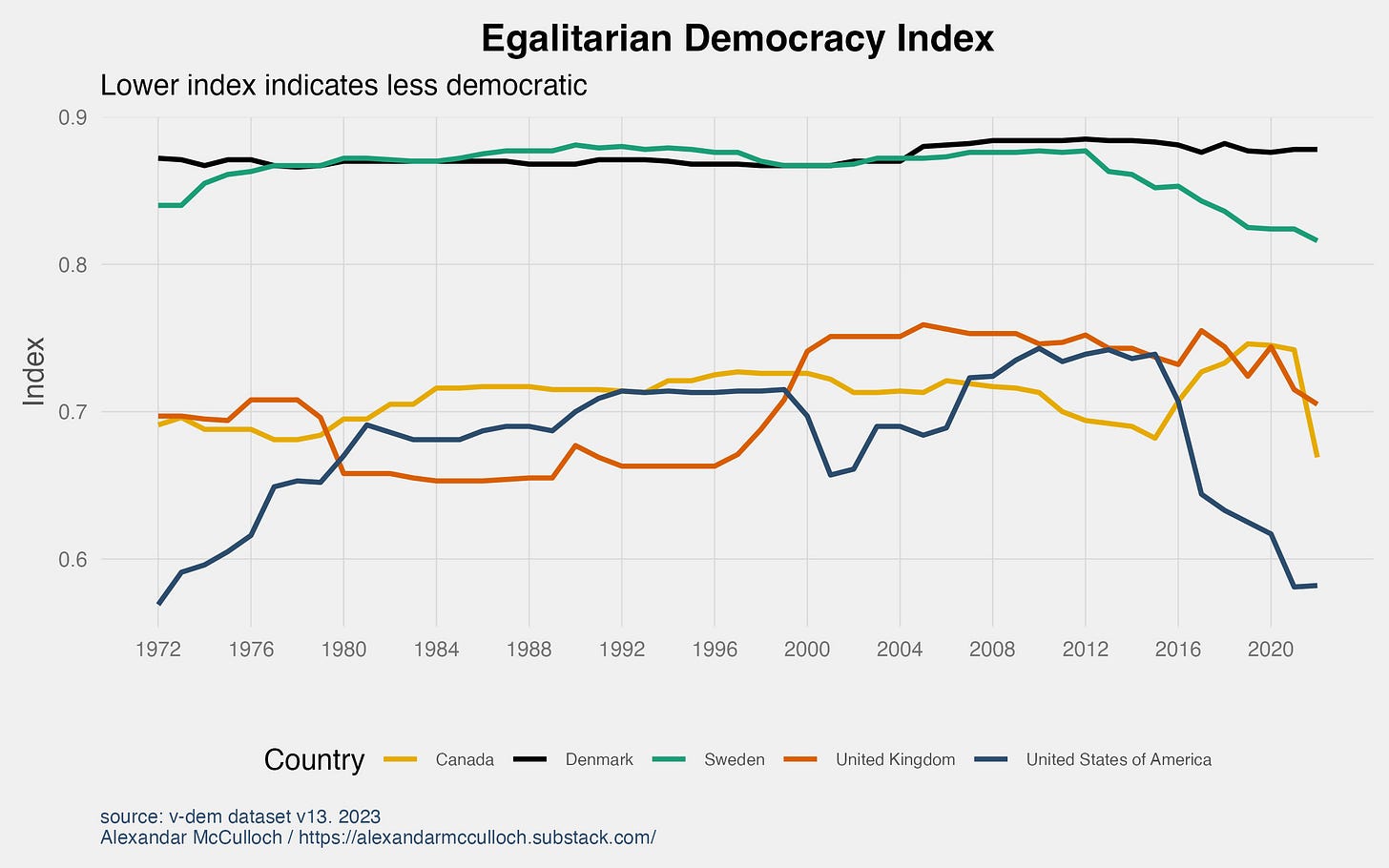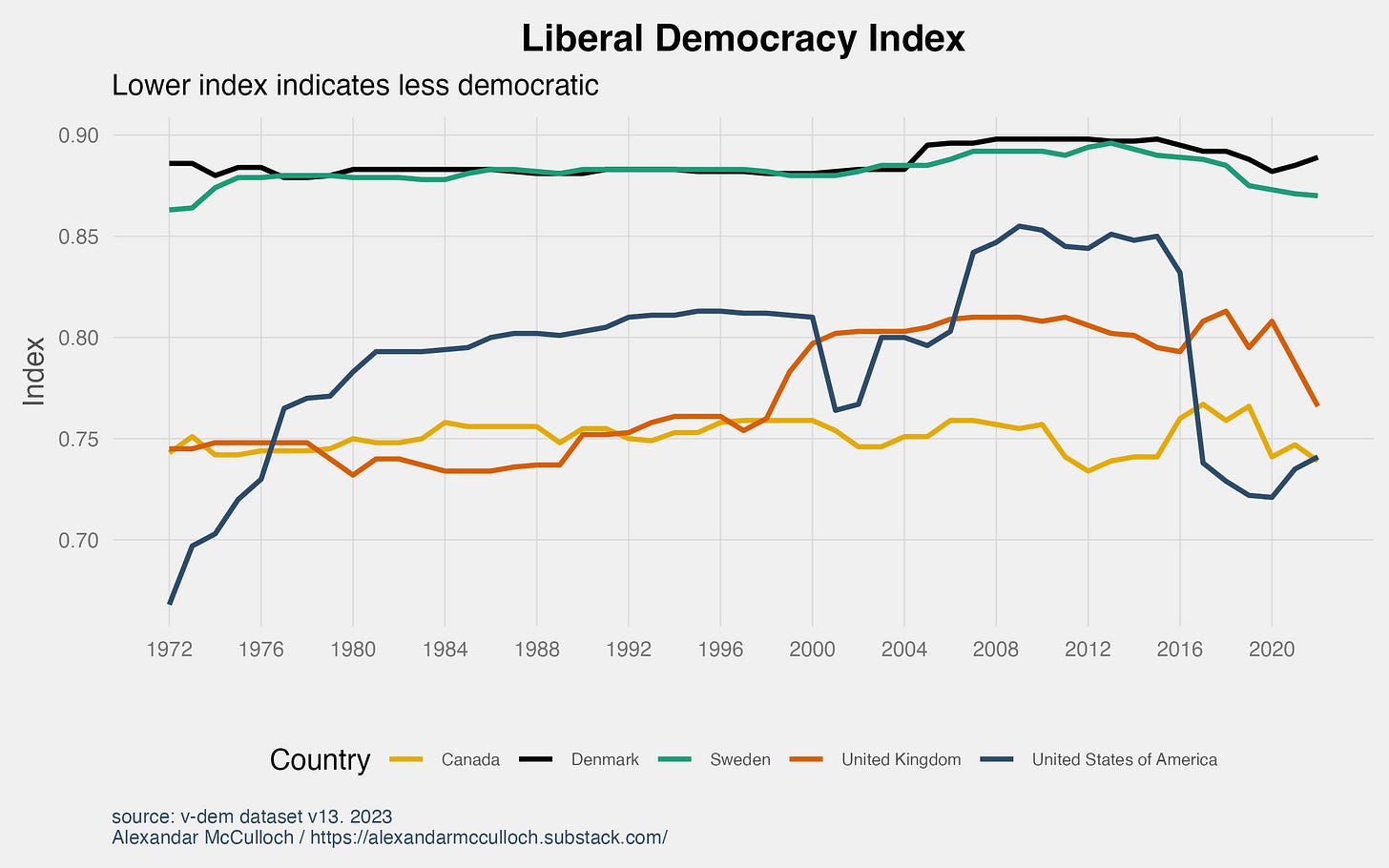A recent CNN poll reports that 38% of Americans and approximately 70% of Republicans believe Biden’s 2020 victory was illegitimate. This skepticism has persisted since the months following the election (see Quinnipiac’s poll here). Following one of the most contentious and skeptical administrations, this confidence gap is not unexpected. Moreover, the legal problems Trump currently faces likely serve to prolong this discouragement felt among the public.
At the time I am writing this, Donald Trump has received three indictments encompassing a total of seventy-nine charges. These charges stem from two federal investigations and one state-level inquiry. Among these, New York has indicted the former president with 34 counts of falsification of business records. Meanwhile, the Department of Justice (DOJ) has indicted Trump on 41 felony counts in the classified documents case. Additionally, the same special counsel, Jack Smith, has charged Trump with an additional four counts relating to the January 6th insurrection case.
This unprecedented situation raises a significant reflection point for Americans. Never before have citizens witnessed a former president facing indictment for any crime, let alone charges of such gravity as those Donald Trump is set to be tried for. This juncture naturally prompts a broader assessment of the health of American democracy, one that transcends political actors and delves into the very structure upon which the American government operates.
Democracy Rankings
Recently, the United States has witnessed a decline in its democratic standing. This shift is underscored by the Economist Intelligence Unit (EIU) downgrading the US from a full democracy to a flawed democracy. Simultaneously, the democracy index maintained by V-Dem (Varieties of Democracy) reveals a consistent drop in the United States’ democratic assessment across a range of key measurements. These concurrent observations highlight a concerning trend that prompts a closer examination of the factors contributing to this decline in democratic performance.
The figure above plots V-Dem’s Electoral Democracy Index, which employs a rating on a scale of 0 to 1. A score of 1 signifies the highest attainable rating within each category. This index captures several essential components: the competitive nature of elections, the assurance of comprehensive suffrage without regard to factors such as race, ethnicity, and gender, the absence of systematic irregularities in elections, and the efficacy of elections in influencing the country’s chief executive. Moreover, in the periods between elections, a fundamental requirement is the prevalence of freedom of expression and an independent media landscape capable of presenting alternative perspectives on political matters.
In the year 2022, the United States received a score of 0.82 on this index. Notably, the graph illustrates that the US hasn’t encountered a score as low as this since 1976 when it was rated at 0.74. For contextual comparison, several other Western democracies such as Denmark, Sweden, and the United Kingdom have garnered higher ratings (with Denmark and Sweden ranking first and second in the world respectively).
This data implies that the United States could be facing heightened challenges in safeguarding voting rights, ensuring competitive elections, and guaranteeing that election outcomes hold substantial influence over the selection of the President.
Turning our attention to Figure 2, we can discern a similar trend. The graph displayed below showcases the Egalitarian Democracy Index. An egalitarian democracy is achieved when 1) the rights and freedoms of individuals are protected equally across social groups; 2) resources are distributed equally across all social groups; and 3) groups and individuals enjoy equal access to power.
The United States witnessed a decline in its egalitarian rating, decreasing from 0.73 in 2015 to 0.58 in 2022, marking a significant 20.5% decrease. While other nations also experienced some decline during this period, the pace of change isn’t consistent with that of the United States. This divergence highlights the unique challenges the United States faces in maintaining an egalitarian democratic framework.
The United States has also garnered a reduced score in the Liberal Democracy Index. This facet of democratic principles underscores the significance of shielding individual and minority rights from both state actions and majority influence. Within this model, the quality of democracy is assessed based on the constraints imposed on governmental powers.
The dataset indicates that the United States may have potentially relaxed or inadequately ensured protections for individuals and minority groups. Furthermore, this index corroborates the trends observed in Figure 2, emphasizing the uneven treatment of specific social groups. The disparity in treatment among these groups hasn’t had such a substantial impact on the United States’ reported democratic performance since the 1970s. This finding underscores the gravity of the nation’s challenge in upholding an equitable democratic framework and safeguarding the rights of all citizens.
During the period between 2015 and 2017, the United States underwent a notable upswing in democratic backsliding, a development carrying substantial ramifications. Particularly striking are the implications pertaining to the treatment of minorities and diverse social groups. This decline in scores aligns remarkably with the dip observed in the electoral democracy score, raising concerns about potential infringements upon the voting rights of specific groups. Such infringements could encompass actions such as curtailing the number of polling stations, reducing opportunities for early and absentee voting, and imposing adjustments to the registration process to heighten its difficulty.
Given the substantial leeway granted to individual states in shaping their own voting laws, the logical progression in our analysis directs our attention toward state politics. As we pivot to another level of analysis, an interesting question emerges: Has this decline in democratic performance been uniformly experienced across the entire country, or is it primarily propelled by a handful of select states?
State Performance
In the context of a federalist system, American states were historically regarded as “laboratories of democracy.” This concept emerged from the significant autonomy granted to states in governing within their boundaries, as long as their laws align with federal regulations. This freedom has facilitated experimentation, a fundamental aspect of federalism highlighted by its proponents. State and local authorities are enabled to address issues that might not capture the attention of the federal government but still impact local populations.
Furthermore, this culture of experimentation encourages states to learn from one another. For instance, if Nevada achieves success in water conservation initiatives, neighboring states like California, Arizona, and Colorado are likely to emulate these practices. Moreover, some states might act as early indicators of more extensive challenges that could eventually affect the entire nation. In such cases, federal legislation can benefit from incorporating measures previously implemented at the state level.
As with most things, there are downsides to this system. National politics casts a looming shadow over state capitols. Thus, state and local lawmakers operate in the shade, capable of delivering reforms that violate democratic norms and principles that often escape widespread notice.
To evaluate the state-level health of democracy, I rely on data compiled by political scientist Jacob Grumbach from the University of Washington. This index employs 51 criteria to gauge democratic performance, with no upper limit on achievable scores. Notably, a positive score reflects robust performance, while a negative score indicates weaker performance.
The maps above illustrate the shift in democratic performance across several states from 2000 to 2018. In the initial year, 2000, states with the lowest democratic performance were concentrated in the deep south, with South Carolina and Alabama holding the lowest rankings. The most pressing change occurred just north of these states, with North Carolina and Tennessee severely underperforming.
A noticeable extension of democratic decline can be observed, spanning from the southern states into certain areas of the Midwest. In 2000, Wisconsin stood as one of the strongest democratic states in the country; however, by 2018, it had descended to one of the five least-performing democracies.
What is striking about this trend is where the magnitude of this decline occurs. States like Ohio and Pennsylvania - historically key battleground states - experienced a decrease in democratic performance while the majority of US states are consistent in their ratings. Moreover, states like Illinois, Colorado, Washington, and California have either seen significant improvement or sustained a healthy democratic score over this period of time.
The provided graph below highlights an uneven democratic performance across states, indicating that not all voters have experienced a robust democratic environment within their respective states. Particularly noteworthy are instances in Texas and North Carolina where abrupt violations of democratic principles have been observed. Notably, North Carolina, once a trailblazer in expanding voting rights during the 1990s and early 2000s, took a sharp turn after the Republican Party gained control of the state’s legislature in 2010. Subsequently, South Carolina Republicans implemented district maps that gerrymandering scholar Christopher Warshaw called “the most gerrymandered map in modern history.”
This is a theme seen in other states. Republicans won Wisconsin’s legislature in 2010 as well. After this victory, the Republican majority, along with Republican governor Scott Walker, enacted heavily gerrymandered maps and stricter voter ID laws. In the 2022 election, Republicans won 75% (6 of 8) of Wisconsin’s seats in Congress despite garnering 56.5% of the total congressional votes.
The question arises: Are Republican states becoming less democratic, or are less democratic states becoming more Republican? With descriptive data alone we cannot definitively say. However, it is apparent that there is a correlation between diminished democratic performance and the prevalence of Republican leadership. The proximity of one often coincides with the presence of the other. Furthermore, Grombach’s research demonstrates that Republican control of state governments notably diminishes a state’s democratic performance. This aspect of Republican leadership holds more substantial predictive power than factors like party competition, polarization, and demographic shifts.
The Series
According to an NPR/IPSOS poll, 64% of the country believes American democracy is in crisis and at risk of failing. Republicans feel this more acutely, likely due to the group’s predisposed belief that Joe Biden is not the legitimate winner of the 2020 election.
These fears are not unfounded. The data shows that the United States has seen a decline in its democratic evaluation. The reduction in democratic evaluation, as depicted by the data, highlights a complex situation that affects different segments of the population unequally. Grumbach’s State Democracy Index sheds light on this variation, underscoring how states like Tennessee, North Carolina, Wisconsin, Missouri, and Ohio have experienced varying degrees of democratic erosion.
While these statistics offer valuable insights, it’s essential to broaden our scope beyond the fixation on specific figures that often dominate discussions. When conversations begin with Donald Trump, it is easy to lose oneself in the proverbial weeds. This is demonstrated by the countless articles and books whose level of analysis begins and ends with the former president. We can pull away from these eristic weeds by broadening our perspective and thoroughly grasp the dynamics of democratic norms, institutions, and their intricate interactions with the public, which serves as the ultimate focus of this series.
In the upcoming discussions, this series will explore a range of subjects including but not limited to polarization, mass and social media, gerrymandering, and the role of interest groups in politics. These explorations aim to provide an encompassing comprehension of the intricate landscape shaping the state of democracy in the United States.
Find the original article published at real-politic.com










